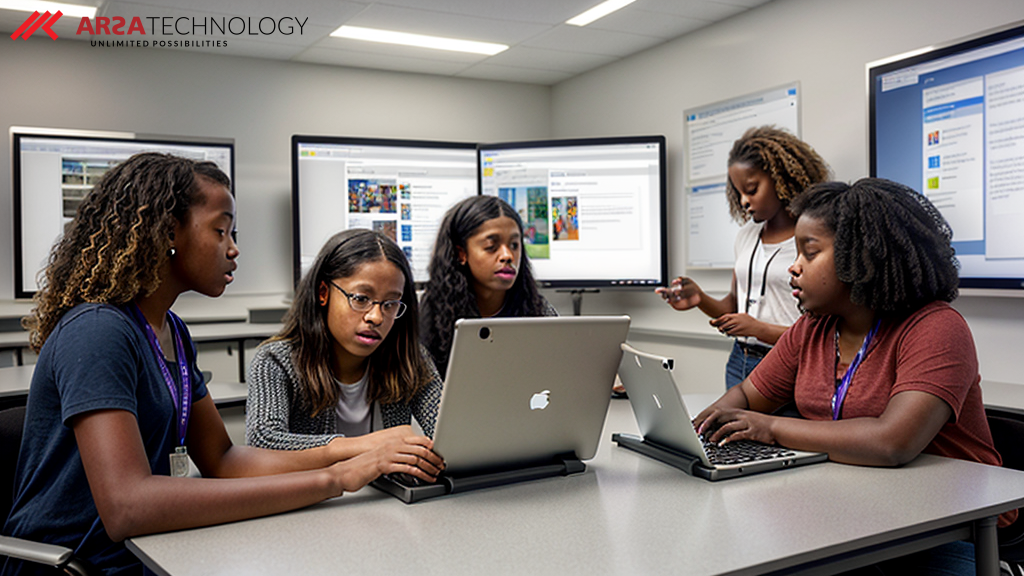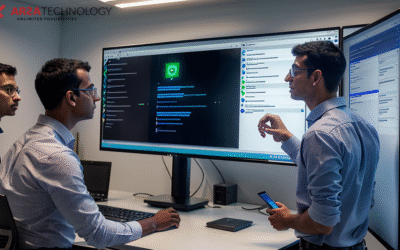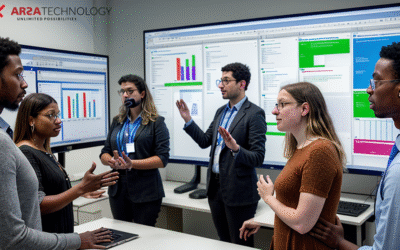Introduction: Overcoming Content Accessibility for Disabled Students in the Education Industry
The pursuit of knowledge is a universal right, yet for millions of disabled students worldwide, accessing educational content remains a significant hurdle. Traditional learning environments often present barriers, from static textbooks that lack auditory alternatives to digital platforms that are not fully navigable without fine motor skills. This disparity not only hinders academic progress but also limits personal growth and future opportunities. The challenge for educators and technology providers alike is to bridge this gap, creating truly inclusive learning experiences that cater to every student’s unique needs.
At ARSA Technology, we believe that artificial intelligence holds the key to unlocking these barriers. Our advanced Speech-to-Text (STT) API is engineered to transform spoken language into accurate, actionable text, paving the way for revolutionary voice-controlled application interfaces. This guide explores how our powerful our highly accurate transcription API can be leveraged to address the critical pain point of content accessibility for disabled students, fostering an educational landscape where every voice is heard and every mind can thrive.
The Imperative for Inclusive Education: Why Voice-to-Text Matters
In an increasingly digital world, educational content is often delivered through videos, online lectures, interactive applications, and digital documents. While these formats offer flexibility, they can inadvertently exclude students with hearing impairments, visual disabilities, or motor skill challenges. For instance, a student with hearing loss cannot fully engage with a lecture without accurate captions, and a student with limited mobility might struggle to navigate complex digital interfaces using a mouse and keyboard.
Speech-to-Text technology directly addresses these issues by converting spoken words into written text. This fundamental capability opens up a world of possibilities for accessibility:
* Real-time Captioning: Instantly transcribing live lectures or pre-recorded videos makes content accessible to deaf and hard-of-hearing students.
* Voice-Controlled Navigation: Empowering students with motor disabilities to interact with learning platforms, complete assignments, and access resources using only their voice.
* Enhanced Learning for All: Providing text transcripts alongside audio content benefits diverse learning styles, allowing students to review material at their own pace and reinforce comprehension.
By integrating robust speech recognition into educational tools, institutions can demonstrate a commitment to inclusivity, comply with accessibility regulations, and ultimately improve learning outcomes for a broader student population.
ARSA Technology’s Speech-to-Text API: A Foundation for Accessibility
ARSA Technology’s Speech-to-Text API is built on cutting-edge AI models, designed for high accuracy and reliability across various languages and acoustic environments. It transforms audio input into precise text, making it an indispensable tool for developing accessible educational applications. Unlike generic transcription services, our API is optimized for enterprise-grade performance, ensuring that educational platforms can handle high volumes of requests with minimal latency.
To see the API in action, demo the Speech-to-Text API. This interactive demonstration allows developers and solutions architects to understand the API’s capabilities and how it processes audio input to deliver accurate text output, without needing to write any code.
Key features that make ARSA’s API ideal for educational accessibility include:
* High Accuracy: Our models are continuously trained on vast datasets, ensuring industry-leading transcription accuracy, even with varied accents and background noise, which is crucial in dynamic classroom settings.
* Multilingual Support: Education is global. Our API supports numerous languages, enabling institutions to provide accessible content to an international student body and cater to diverse linguistic needs.
* Real-time and Batch Processing: Whether it’s live captioning for a virtual lecture or transcribing hours of recorded seminars, our API offers flexible processing options to meet different demands.
* Scalability: Designed for global enterprises, our infrastructure scales effortlessly to accommodate the needs of large educational institutions and growing user bases, ensuring consistent performance.
Transforming Education: Practical Use Cases for ARSA’s STT API
The integration of ARSA’s Speech-to-Text API unlocks a myriad of innovative applications within the education sector, directly addressing the core pain point of content accessibility and fostering inclusive learning environments.
1. Automated Live Captioning for Lectures and Webinars:
For students with hearing impairments, live lectures can be a significant challenge. Integrating our STT API allows for the real-time generation of captions, displayed directly on screens or personal devices. This ensures that every spoken word is simultaneously presented in text, enabling full participation and comprehension. This also benefits students who prefer to read along or need to review complex terminology.
2. Voice-Controlled Learning Management Systems (LMS) and Applications:
Students with motor disabilities often face difficulties navigating complex digital interfaces. By embedding voice control into LMS platforms, e-learning applications, and digital textbooks, students can interact using simple voice commands. Imagine saying “Open Chapter 5,” “Go to next page,” or “Submit assignment” – this level of hands-free interaction empowers students to independently manage their learning journey.
3. Interactive Study Tools and Note-Taking Assistants:
Our STT API can power intelligent note-taking applications that transcribe lectures as they happen, allowing students to focus on understanding rather than frantically writing. These transcripts can then be easily searched, highlighted, and annotated. For students with learning disabilities like dyslexia, converting spoken instructions into text can provide a clearer, reviewable format.
4. Enhanced Language Learning and Pronunciation Practice:
While primarily an accessibility tool, the STT API also serves as an excellent aid for language learners. Students can practice speaking a new language, and the API can provide real-time transcription, helping them identify pronunciation errors and improve fluency. This interactive feedback loop is invaluable for developing conversational skills.
5. Transcribing Student Presentations and Discussions:
For group projects or classroom discussions, the ability to transcribe spoken contributions offers multiple benefits. It provides a written record for review, allows educators to assess participation more accurately, and ensures that the contributions of all students, including those who may struggle with written expression, are fully captured.
6. Creating Accessible Digital Content:
Beyond live interactions, the API can be used to convert audio recordings of podcasts, interviews, or legacy educational materials into searchable text. This makes a wealth of previously inaccessible content available to a wider audience, enhancing the overall digital library of an institution.
Furthermore, combining our Speech-to-Text capabilities with our generate natural voice responses with our TTS API opens up even more possibilities. Imagine a voice-controlled application that not only understands spoken commands but also responds with natural-sounding speech, creating a truly immersive and accessible conversational interface for learning.
Driving Business Value: ROI and Strategic Advantages for Educational Institutions
Implementing ARSA Technology’s Speech-to-Text API is not just about compliance or goodwill; it’s a strategic investment that yields tangible business benefits for educational institutions:
- Expanded Reach and Enrollment: By offering truly accessible learning environments, institutions can attract a broader and more diverse student population, including those who were previously underserved. This expands market reach and potential enrollment figures.
- Enhanced Student Retention and Success: When students feel supported and can fully access content, their engagement and academic performance improve. This leads to higher retention rates and better overall student success, enhancing the institution’s reputation.
- Operational Efficiency: Automating transcription of lectures, meetings, and student interactions reduces the need for manual transcription services, leading to significant cost savings and more efficient resource allocation.
- Competitive Differentiation: Institutions that proactively adopt advanced AI for accessibility position themselves as leaders in educational innovation, setting them apart from competitors and appealing to forward-thinking students and faculty.
- Compliance and Risk Mitigation: Adhering to accessibility standards (e.g., WCAG, ADA) is not just good practice but often a legal requirement. Implementing robust STT solutions helps institutions meet these obligations, avoiding potential legal challenges and reputational damage.
- Future-Proofing Education: Investing in AI-powered accessibility solutions prepares institutions for the future of learning, where personalized, adaptive, and inclusive technologies will be paramount.
Best Practices for Integrating Speech-to-Text in Education
Successful integration of an STT API requires a thoughtful approach focused on user experience and data privacy:
1. Prioritize User Experience: Design voice interfaces that are intuitive and responsive. Ensure clear feedback mechanisms so students know their commands have been received and processed.
2. Ensure Data Privacy and Security: Educational institutions handle sensitive student data. Choose an API provider like ARSA Technology that prioritizes robust security protocols and compliance with data protection regulations.
3. Test with Diverse User Groups: Involve disabled students in the testing phase to gather feedback and refine the voice-controlled interfaces and transcription accuracy for real-world scenarios.
4. Provide Training and Support: Offer clear guides and support for both students and faculty on how to effectively use the new voice-enabled tools and accessible content.
5. Monitor Performance and Iterate: Continuously monitor the accuracy and performance of the STT integration. Leverage analytics to identify areas for improvement and iterate on the solution to enhance its effectiveness over time.
6. Consider Multilingual Needs: For diverse student bodies, ensure that the STT solution can accurately process and transcribe multiple languages, providing equitable access to all.
Conclusion: Your Next Step Towards a Solution
The journey towards truly inclusive education is ongoing, but with powerful tools like ARSA Technology’s Speech-to-Text API, significant strides can be made. By embracing voice-controlled interfaces and automated transcription, educational institutions can dismantle barriers, empower disabled students, and create a learning environment where every individual has the opportunity to reach their full potential. The strategic advantages—from expanded reach and enhanced student success to operational efficiency and competitive differentiation—make the case for integration compelling.
ARSA Technology is committed to providing the robust, accurate, and scalable AI solutions that drive this transformation. We invite you to explore the capabilities of our Speech-to-Text API and begin building the next generation of accessible educational applications.
Ready to Solve Your Challenges with AI?
Discover how ARSA Technology can help you overcome your toughest business challenges. Get in touch with our team for a personalized demo and a free API trial.







